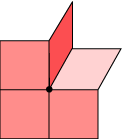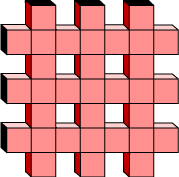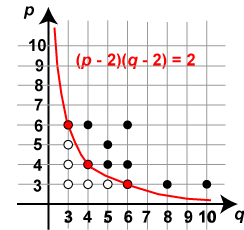|
REGULAR PSEUDOOPOLYHEDRA
Every now and then in mathematics one experiences a dramatic ‘Aha!’ moment – a moment of excitement, exhilaration and wonder. This happened to me long ago when I first came across a paper by one J. R. Gott (listed below in the references). Here was a natural simple question, with an ‘obviously’ impossible answer, which led to a whole new class of polyhedral figures. In fact Gott titled his paper Pseudopolyhedrons, but it seems more natural to use the more conforming ‘pseudopolyhedra’. All the ideas in this section are taken from Gott’s work; in fact, no-one seems to have followed up on Gott’s ideas. Let us illustrate the idea using a simple example. From our work on regular polyhedra, we know that for a given regular solid, all the faces are congruent and regular, and the faces around each vertex are arranged in like manner. The same is true for each regular tessellation. Now let us consider figures made up of square faces.
Now check your results ...
Now that we have seen that such figures are possible, many questions come to mind. How many pseudopolyhedra are there? What do they look like? Are they all infinite in extent? We observe that Gott places a couple of further constraints on his regular pseudopolyhedra. He insists that (i) just two polygonal faces may meet at an edge, and (ii) two polygons may share no more than one edge. It is unnecessary to state these conditions for the regular convex polyhedra or tessellations, but for the pseudopolyhedra, more complicated possibilities arise. Notice, for example, that condition (ii) precludes pseudopolyhedra having coincident faces. |
|
|
The actual number of regular pseudopolyhedra is not know for certain. Gott found seven, although three of these had in fact been discovered earlier by J. F. Petrie and H.S.M. Coxeter. We shall look at these seven pseudopolyhedra shortly. It is of some interest to draw a graph showing the various possibilities, as this shows the relationship between the regular polyhedra, tessellations and pseudopolyhedra. Using the Schläfli symbol {p, q} as indicated above for a figure having regular p-gons for faces, q meeting at a vertex, we can plot p against q. Then each figure is represented by a point (p, q) on this graph. As we have seen, the three regular tessellations (3, 6), (4, 4), and (6, 3) lie on the hyperbola (p – 2)(q – 2) = 4. The five regular polyhedra lie below this hyperbola, and we shall find that the seven pseudopolyhedra lie above. The resulting graph looks like this:
It is easy to show that the points representing the pseudopolyhedra all lie below the graph. Theorem For every regular pseudopolyhedra, (p – 2)(q – 2) > 4. Proof: Let A denote the face angle of the given pseudopolyhedron. Since q faces meet at a vertex, we have q.A > 360° q(180° – 360°/p) > 360° q – 2q/p > 2 pq – 2q > 2p (since p > 0) pq – 2(p + q) > 0 (p – 2)(q – 2) > 4 as required. Gott establishes a number of other properties of the pseudopolyhedra, but it is clear that there is more work to be done in this area.
Gott, J. R., ‘Pseudopolyhedrons’, American Mathematical Monthly, May 1967, 497 – 504. |

 The figure at left shows that this is possible. We think of this ‘lattice’ structure extending indefinitely up and down, left and right. It would be reasonable to denote this by {4, 5}, as the faces are squares ({4}s), and there are five squares meeting at each vertex.
The figure at left shows that this is possible. We think of this ‘lattice’ structure extending indefinitely up and down, left and right. It would be reasonable to denote this by {4, 5}, as the faces are squares ({4}s), and there are five squares meeting at each vertex.